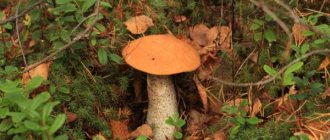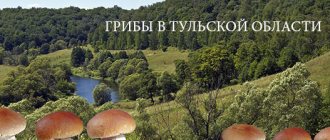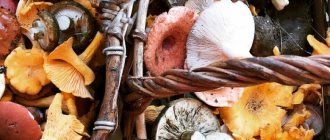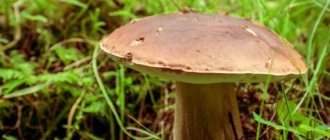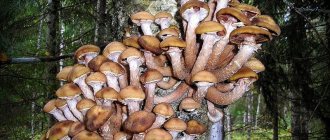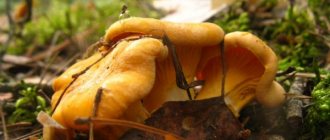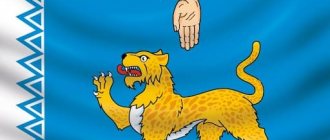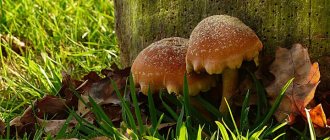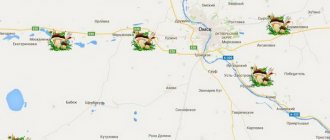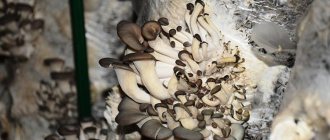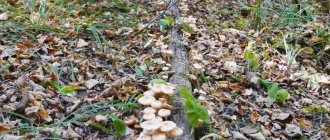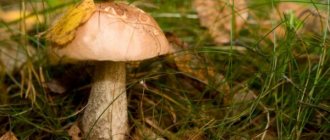Mushrooms
0
2856
Article rating
Kira Stoletova
The lands of the Ryazan region have long been famous for the abundance of their forests. They occupy a huge area here. Mushrooms in Ryazan are very diverse. Festivals are held in their honor, legends are made, and monuments are erected.
Mushrooms in Ryazan
What mushrooms grow
The Ryazan region, after the Moscow region, is the richest region in central Russia in mushrooms. Moderately dry summers, heavy rainfall in autumn, the presence of reservoirs and clean forests create favorable conditions for the growth of more than 100 species of edible mushrooms. In 2022, the following edible and conditionally edible mushrooms will grow in the Ryazan region:
- white;
- Polish;
- milk mushrooms;
- boletus;
- boletus;
- chanterelles;
- boletus;
- Russula;
- honey mushrooms;
- goats;
- flywheels.
White boletus, Polish white boletus, boletus and boletus grow in mixed forests. They hide under trees and in berry bushes. Whites love hills. Butterflies are found mainly in coniferous forests. Milk mushrooms, porcini mushrooms, boletus mushrooms and boletus mushrooms are universal mushrooms. They have good taste and unique nutritional value. They are boiled, fried, pickled, dried and frozen.
Tea
Not everyone knows that you can bring excellent tea. Both in economical and souvenir packaging. The tea-packing factory has been operating here since 1954. Tourists are recommended to purchase products from the “Yeseninsky Tunes” line with a photograph of the poet on the box. This line includes both green and black loose leaf tea - Chinese, Indian, Ceylon. All products are of the highest quality, have a mild taste, invigorate, and drive away fatigue. Another interesting line is “Unusual” tea. Various options are offered - with the aroma of lemon, strawberry, bergamot, wild berries, tropical fruits.
The products of the “Cities of Rus'” line are packaged in tin cans, stylishly designed and decorated with images of architectural monuments. “Moscow”, “Ryazan”, “Vladimir”, “Yaroslavl”, “Tula” - any tea from this series will be an excellent gift. Each jar contains premium black Indian tea. The series “Favorite Cities of Russia” continues this line. Also on sale is Indian tea in tins decorated in the style of New Year's cards.
Map of mushroom places
The Ryazan region is rich in mushroom places. Mushroom places are distributed throughout the entire territory of the Ryazan region. Map of places most popular among mushroom pickers:
- Ryazan district, villages Laskovo and Deulino. In the forest areas around the villages, boletuses, boletuses, chanterelles, and boletus are collected.
- The area near lakes Chernenkoe and Segdenskoe. In swampy areas, boletuses, white and white boletuses are collected in September.
- Kiritsky forest near the villages of Shelukhovo and Zadubravye. All the edible species characteristic of the region grow there.
- Forest near the Iberd village. White chanterelles and moss mushrooms grow on the right bank of the Ranova River.
- Klepikovsky district of the village. Tuma. In the forest belt north of the settlement all types of edible mushrooms grow. They go out to collect with caution due to the abundance of snakes. Chuchkovsky district, Nazarovka village.
- White boletuses, boletuses, boletuses and boletus grow in marshy areas. Kasimovsky district. Throughout the Kasimovsky district, large harvests of edible mushrooms are harvested throughout the season.
- The most popular place among mushroom pickers is the village of Kochemary. Wild boars, wolves, foxes and snakes are found in the forests, so it is important to follow the rules of behavior so as not to provoke an attack.
Ticks are also dangerous. Be sure to go hunting in closed clothing, take protective equipment and vegetable oil with you in order to safely remove the insect.
Map of the Ryazan region.
Village of Deulino, Ryazan region
In the forests that remained after the forest fires of 2010, you can find almost any mushroom, but most of all tubular mushrooms: boletus, aspen, porcini, Polish boletus, and chanterelles. In pure pine forests you can find boletus. If the weather is good, you can fill a whole basket in a few hours. How to get there: by minibus from the Prioksky bus station or by private car to the village. Affectionately, then turn right, then left... Mushrooms are collected either in the forests near the village, or cross the wooden bridge to the other side of the Pra.
Area of Chernenkoe and Segden lakes
The places are swampy, which leaves its mark on the species composition of mushrooms. Mostly found here are Polish white, moss boletus, aspen boletus and boletus. In autumn there is an abundance of pigs, but who needs them if there are a lot of normal, edible mushrooms all around? After all, scientists have recognized this mushroom not only of low value, but also poisonous (its toxins can accumulate in the body).
The best time for collecting is September, when the wave of vacationers has subsided and there are no mosquitoes, which are so abundant in these places in the summer. How to get there: by minibus or bus from the Prioksky bus station to the village of Laskovo or by minibus going to Priozernoye. By personal car - to the village. Affectionately, then turn right.
Kiritsky forest
A fairly accessible place for residents of the regional center. A little over an hour by train - and you are in mushroom paradise. During the mushroom season, the electric train departing for Sasovo at the beginning of five in the morning often consists of 90% mushroom pickers, more than half of whom are sent to these places. Everything from russula to white mushrooms is represented there. How to get there: from the Ryazan-1 train station by train going to Sasovo, to Sq. 270 km, Shelukhovo, Zadubrovye. By car - along the M5 highway.
Interesting read: Polypores: where they grow and what are their beneficial properties
Nazarovka village, Chuchkovsky district
The forest here is mostly spruce, and the soil is more swampy. In addition, the place is quite remote from the regional center. Reduced human pressure has a beneficial effect on the local environment. In these places you can often find porcini mushrooms. There are also many other tubular mushrooms - boletus, boletus, and moss mushrooms. But there are few chanterelles and butterfish - this is not their environment. How to get there: from the Ryazan-1 railway station by train going to Sasovo to the station. Nazarovka. By car - along the M5 highway to Putyatino, then, after the bridge over the river, turn left and drive about 20 kilometers to the railway station.
Iberd forest
Mostly deciduous trees grow, but there are also islands of pine. Located on the right bank of the Ranova. Mostly Polish whites, moss mushrooms, and chanterelles are collected here. Boletus, boletus, boletus and chanterelle are less common here. Very beautiful places where you can relax your body and soul. How to get there: from the Central bus station by bus going to Sarai or Ukholovo. You need to get off either in the village of Kipchakovo or in the village of Iberdsky. By car - along the Ryazhskaya highway, then, after Pekhlets, turn left (signpost Sarai, Ukholovo).
The village of Tuma, Klepikovsky district
The mushroom places here are located a little north of the village, towards the Vladimir region. The species composition of mushrooms is everything that grows: from white to goat, from milk mushrooms to russula. If the weather is good, the mushroom season lasts from July to October. But when visiting the forest, you should be careful - there are many snakes in the forest. How to get there: from the Prioksky bus station by bus going to Tuma, Vladimir, Kasimov, Murom, Gus-Khrustalny. From the bus station, walk a kilometer to the railway crossing, then left along the railway. By car - along the Kasimovskaya highway to the village of Tuma, then turn towards Vladimir and drive about five kilometers.
Material on the topic: Golovach: a tasty and healthy mushroom of gigantic size.
Candies
That's not all. The candies produced by the Kasimov confectionery factory are famous both in the city and beyond. “Loyalty to quality” is not only the name, but also the real motto. The choice is so rich that it makes your eyes wide open. Personalized chocolate and sweet souvenirs with company logos, gift sets, themed gifts - for example, for Knowledge Day or Teacher's Day. And what kind of handmade sweets are there? With orange, banana, cherry cream, lingonberry marmalade, marzipan, caramel, nuts, liqueur…. A real paradise for those with a sweet tooth.
This box will decorate any holiday table. You can also find handmade sweets in the city, sold by the ChocoTime chocolate workshop. They believe that properly prepared chocolate should shine and crunch when broken. Here you can also order a cake - elegant and refined.
Bar and broken chocolate with various types of nuts, hot chocolate, which is poured into cups - you simply cannot take a child away from the coffee shop that operates at the workshop. ChocoTime also conducts master classes during which you can learn the basics of confectionery art. “Tasty” souvenirs are sold in company stores. It is recommended to buy sweets in bulk from supermarkets or purchase them in gift boxes in souvenir shops.
Top 10 mushroom places in the Ryazan region
Social networks are full of photographs of buckets overflowing with mushrooms. They say that even while stuck in a traffic jam, you can pick up a hefty bag of boletus and white boletus. There are many who have collected buckets of mushrooms directly from their summer cottages. “Meshcherskaya Side” has compiled its top 10 most mushroom places in the Ryazan region.
- The village of Laskovo, Ryazan region. It’s not for nothing that a mushroom festival is held here every year. In the forests surrounding the homeland of the famous Fevronia, there are so many mushrooms that “you can even mow them with a scythe.”
- The village of Novaya Derevnya, Putyatinsky district. Due to unemployment in the village, most local residents are engaged in “harvesting” and selling mushrooms. And, they say, mushroom pickers make good money from this.
- The village of Dubrovichi, Ryazan region. Just a 30-minute drive from Ryazan, everyone can return with full baskets of boletus and porcini mushrooms.
- The village of Zanino-Pochinki, Shilovsky district. There are an abundance of pine forests in these areas. Therefore, this September, according to local mushroom pickers, there were a lot of mushrooms.
- The village of Kochemary, Kasimovsky district. Kasimov has long been famous for its mushroom places, and along the entire route people sell mushrooms. But it is in the Kochemar forests that most mushrooms grow.
- The village of Fedotevo, Spassky district. Already at the turn to the village there are abundant birch forests, in which you can search for boletus mushrooms, porcini mushrooms, and chanterelles with honey mushrooms.
- The village of Kriusha, Klepikovsky district. In general, the forests of this area are not only protected, but also mushroom. They are rich not only in mushrooms, but also in berries, including cranberries, which have already ripened in the local swamps.
- The village of Ungor, Putyatinsky district. Here in the large forests, on the contrary, there are, surprisingly, few mushrooms. But in small forests they are abundant. And just a few minutes drive from the village.
- The village of Nazarovka, Chuchkovsky district. Most often in the forest here you come across porcini mushrooms, which are also popularly called “dear” mushrooms.
- The village of Tuma, Klepikovsky district. Here you can find mushrooms for every taste. Everything grows in the Tuma forests: from russula to milk mushrooms.
Mushrooms are collected only with stems. It is by the legs that poisonous species are identified during sorting. If you decide to buy more mushrooms, pay attention to the fact that the caps must have stems. If the seller offers only “heads” of mushrooms, refuse to purchase. You will not be able to accurately determine whether the mushroom in front of you is a poisonous or an edible one.
Kadomsky Veniz
Embroidery in the Kadom Venise style is unique in that it is done white on white. This type of embroidery arose during the reign of Emperor Peter the Great, when rich people wore underwear and outerwear with lace. Why "veniz"? Because Venetian lace made a great impression on fashionistas, and local needlewomen began to master the technique. And everything worked out.
The Kadom factory has received many awards for its products presented at various exhibitions.
In local stores you can find a great variety of different products with embroidered symbols of the region. Elegant and delicate work is a real work of art. There is no doubt that your friends will treasure such a gift.
Tips for beginner mushroom pickers
- For the first time, it is better to go on a quiet hunt with an experienced person who knows mushrooms well.
- It is best to go mushroom picking in the morning - between 6 and 7 o'clock.
- The golden rule of a mushroom picker is “if you’re not sure, don’t take it!” It is better to leave a suspicious mushroom in the forest.
- To avoid getting lost, study the map of the area in advance. Take a fully charged mobile phone with you.
- A novice mushroom picker would do well to use a mushroom guide to distinguish between poisonous and false ones.
- Harvesting near roads and industrial enterprises is prohibited. The fruiting body easily absorbs harmful substances (heavy metals, combustion products, etc.) from the air and soil. Old specimens are especially dangerous.
- Throw away worms - they are harmful to the human body, causing poisoning and allergies.
- Do not take rotten mushrooms - even after removing the rotten parts, the taste of the remaining ones will be hopelessly spoiled.
Edible varieties
boletus
One of the favorites among mushroom pickers. The color of the cap is from light gray to brown, the leg is gray-white, scaly. Prefers birch forests, also found in mixed forests.
In all types of boletus, the cut flesh does not change its color under the influence of atmospheric oxygen. Since all species are edible, very often mushroom pickers do not distinguish between them, uniting them under one name - “boletus”. Only the most inquisitive try to find out the characteristics of each species in order to find out where and when it is best to collect them, which means returning from the “quiet hunt” with a full basket.
Collected from early summer to late autumn. A rich harvest of boletus can be collected even in young birch forests.
Boletus
It comes in red, yellow-brown and pine. They differ from boletus mushrooms in having a thicker stem and a dense cap. The color of the cap is red-orange (rarely white), the stem is velvety, white. A characteristic feature is that the flesh becomes bluish-black when cut.
Collected from June to October in aspen forests. It is also found in mixed and pine forests.
Porcini
Boletus has an excellent nutty taste. The color of the cap is from whitish to dark brown, the leg is thick, massive, slightly lighter. The pulp is dense, white.
People believe that the white mushroom and the fly agaric go hand in hand with each other: if fly agarics have appeared, you can go in search of the white mushroom.
Grows from June to October in deciduous, coniferous and mixed forests. Fruits in waves.
Milk mushrooms
They are distinguished by their special cap shape: pressed in the center with curved fringed edges. The color of the cap of different species can be white, light brown, golden, or black. The leg is short.
The mushroom hides under fallen leaves and is found in large groups towards the end of summer and autumn in deciduous, coniferous and mixed forests.
Milk mushrooms form mycorrhizae with a number of tree species, in particular with birch, spruce and willow.
Chanterelles
It can be recognized by its unusual shape, reminiscent of an umbrella turned outward: the cap is almost completely fused with the stem.
Chanterelle is one of the most famous edible mushrooms. As with champignon, successful experiments were carried out with it in the early 1970s on growing the mycelium of these mushrooms using the “deep cultivation” method. Everything went well from the point of view of high biological productivity, but an insurmountable obstacle was the complete lack of specific taste and aroma of the “artificial mushrooms.”
The color of the mushroom ranges from light yellow to bright orange. Found from June to October, growing in families.
Russula
Small fragile specimens with a white stem and a cap of various colors (white, pink, green, yellowish, light brown, gray, black). The skin of the cap is usually dry and only sometimes cracks. Collected from mid-summer to late autumn in deciduous and mixed forests.
Some species are conditionally edible, so it is recommended to soak or boil them before cooking.
Butter
They got their name from the slippery, oily cap of young mushrooms, covered with an easily removable skin. Its color ranges from yellow to dark brown, the leg is slightly lighter. It is yellow below (it darkens in older mushrooms) and consists of thin tubes.
Collected from early summer to mid-autumn, most often found in coniferous forests.
Honey mushrooms
Can be found on old stumps, fallen tree trunks, and just on the ground. The cap is light yellow to dark brown, the thin leg is slightly lighter, and has a characteristic skirt.
They grow in large groups in the forest from early summer to late autumn.
Poisonous varieties
Fly agaric is easily recognized by its bright color
In the Ryazan region you can also find poisonous mushrooms that cause poisoning. The most dangerous are the fly agaric and toadstool.
fly agaric
Grows in coniferous and deciduous forests, in groups or singly. They are easily recognized by their bright red cap with white specks (there are mushrooms with yellow or orange). The leg is white, with a skirt.
Interestingly, the name “fly agaric” originally referred only to the red fly agaric, the tincture of which was used in the fight against flies. Subsequently, it was assigned to all species of this genus.
Found from early summer to November.
Death cap
Deadly poisonous mushroom. The color of the cap is from white to grayish-green, the leg is white or the same shade as the cap. The leg below has a tuberous thickening and a volva similar to a pouch. Grows in light deciduous and mixed forests from late summer to late autumn.
Prefers damp places.
Pale toadstool is sometimes confused with russula or champignons. It should be remembered that the former are fragile, while the latter have darker plates on the back of the cap.
False honey mushrooms
They are dangerous. It is very important to know the signs of real mushrooms so as not to confuse them.
- The main difference is the presence of a skirt on the leg of a real honey mushroom.
- False ones are brighter: brick red, orange, rusty brown. However, there are inedible gray-yellow mushrooms that can easily be confused with genuine ones.
- Poisonous ones smell unpleasantly of earth or mold.
Other dangerous mushrooms
The false chanterelle is also found in the forests of Meshchera, which differs from the real one in its fiery red color and also has a very unpleasant taste.
Experienced mushroom pickers do not recommend collecting pig mushrooms (they have a cap from olive-brown to dark brown and a short stem. They grow from June to October, usually in large groups).
Previously, they were considered conditionally edible, but now they are considered poisonous. The toxin accumulates in the human body throughout life and can cause severe allergic reactions, liver and kidney damage, and anemia. However, the concentration level of the particular compound (antigen) that causes these problems varies from person to person. Therefore, someone can eat them all their life and will be healthy, but for someone even one time will be enough for something irreparable to happen. By the way. It is not possible to determine the maximum concentration of this antigen.
If symptoms of poisoning appear (nausea, vomiting, abdominal pain, fever, weak pulse), you should definitely seek medical help.
Clothing and home textiles
If beer is of interest primarily to men, then ladies will be happy to stroll through stores that sell clothes and home textiles. What will Ryazan please you with? It's worth taking a closer look at the products. You will find excellent knitwear - high quality and at reasonable prices. Moreover, all things are fashionable. The best imported equipment is used in the development and production of products. Things look elegant and expensive.
Moreover, you can choose clothes of any size. The materials used are durable and high quality; you can make an individual order by choosing yarn, accessories and model. Here they pay exceptional attention to all the wishes of the customer. If you come to the city for a short period of time, you will only have time to order the product and receive it at home. Also, many will be interested in the products of the Tefiya clothing company. It includes both clothing and home textiles.
Robes for women and men, bed linen, home clothes, dresses and suits, children's clothes, bedspreads, pillows, bags - you can buy all this as a souvenir of the city. In short, you are unlikely to leave this hospitable city empty-handed. And may all purchases bring joy to you, your friends and loved ones.
- The most expensive hotels in the Maldives
- Bansko hotels near ski lifts
- 25 best ski resorts in Russia
- 15 best things to do in Krasnaya Polyana for children
- Travelat promotional codes for August-September 2021
- All inclusive holidays in Cyprus
- 15 best resorts in Turkey
- Navy Day 2022 in St. Petersburg: program for July 25, 2021.
- What to see in Istanbul in 5 days - 30 most interesting places
- Alushta in December
- 25 best excursions in Sochi
- St. Petersburg in December
